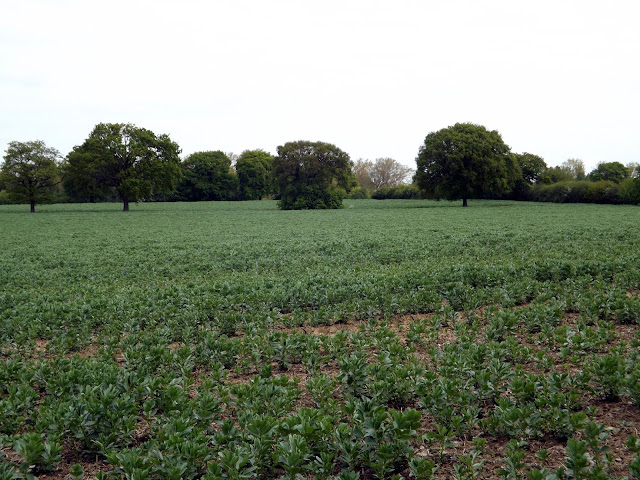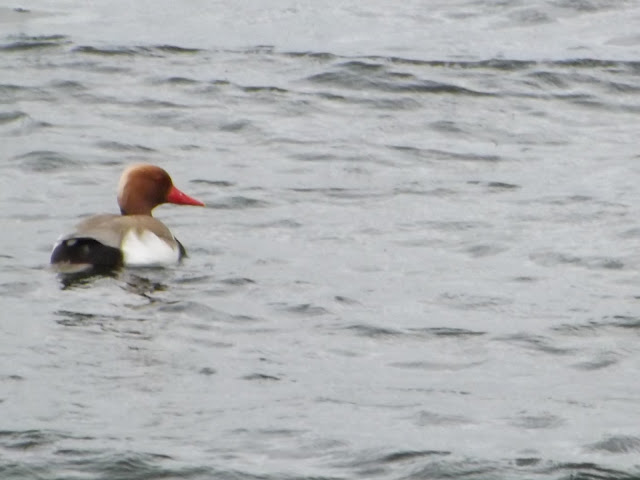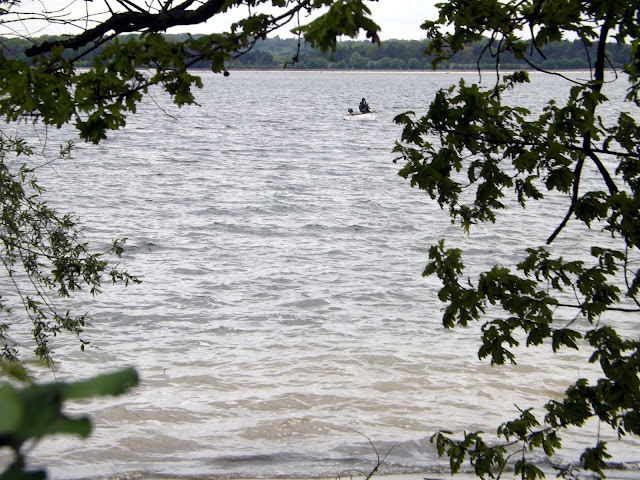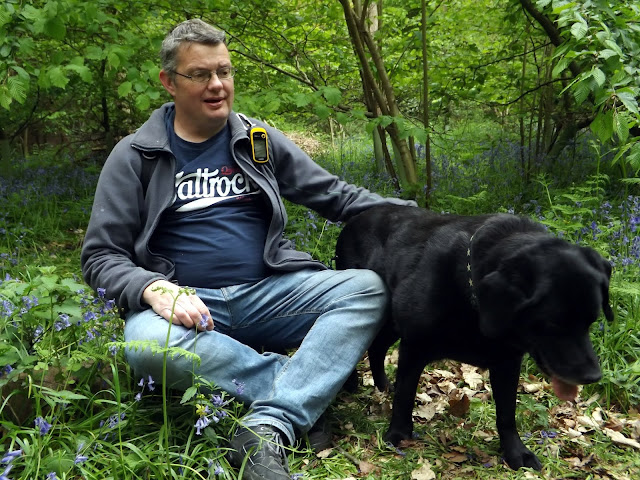GPX file here
On Bank Holiday Monday the 6th of May 2019 I met Dan at the Essex Wildlife Trust Visitor Centre at Hanningfield Reservoir. Only to be told as we walked away from our cars by a member of staff that dogs are not permitted in the reserve. Madness,something to do with disturbing wildlife. But hey I wan't going to let that stop me doing this walk. So I decided to do the walk in reverse as we wouldn't have to go through the visitor centre.
The reservoir is one of the premier fisheries in the UK providing some of the best reservoir trout fishing by either bank or boat.
The reservoir is the 11th largest reservoir in England with an area of 3.5 square kilometres (880 acres). The reservoir was formed by W. & C. French in 1957 at a cost of about £6m, by flooding an area of South Hanningfield covering the ancient hamlet of Peasdown.
Giffords Farm and Fremnells Manor were also flooded. Contrary to popular belief, no buildings survive under the water, however an earth removal machine was left 'in situ' and concreted over prior to filling. The reservoir was built in an area formerly known as Sandon Valley, and large parts of the reservoir and surrounding countryside have been developed as a nature reserve.
The Wind in the Willows Sculpture & Brass Rubbing Trail features stunning, large-scale wooden sculptures of characters from Kenneth Grahame’s much-loved book The Wind in the Willows, first published in 1908. All the favourite characters are there: Mole, Ratty, Toad and Badger – as well as two dastardly Weasels.
The trail follows paths through the stunning woodland of the Trust nature reserve, with fantastic views of the reservoir (which is owned by Essex & Suffolk Water). People can purchase trail guides in the Trust’s visitor centre and then embark in Mole’s footsteps, into the ‘Wild Wood’, to seek out the sculptures. Beside each sculpture is a brass rubbing, from which people can fill in images of the characters on spaces in the guide, by using the crayons provided.
The Trail opened to the public on Saturday 28 March, before an official opening event later this year. It is the latest is a series of The Wind in the Willows-themed activities and events at Essex Wildlife Trust Hanningfield Reservoir. Last year, The Wind in the Willows Wildlife Garden, which features Ratty’s Boat and Toad’s Caravan, opened.
We head off down Hawkswood Road and try to stay tight in as there is no pavement and fast cars!
We pass by the reservoir and our first view of it.
We pass Crowsheath Fishery. The lakes are set in 110 acres of picturesque farmland, woodland and rolling countryside with an abundance of wildlife. There are three lakes at Crowsheath, the main carp and pike lake stocking carp up to 42lbs with 7 known 30′s and plenty of 20′s. With loads of pike up to lower mid twenties for a great bit of winter sport. There is a catfish lakeholding the UK’s largest mandarin catfish which has tipped the scales at 72lbs previously with other catfish up to 92 pound. There is also a coarse and carp lake and is perfect for a spot of float fishing or carpers who just want a bend in their rod.
A sign warns of Deep Sludge and a risk of sinking!
Thankfully today the mud is all but dried out for now!
We follow the footpath, but I wanted to get alongside the waters edge if we could, so I decide on trespassing. ( I have amended the GPX file so you don't have to). This was in vain as there was no way to get beside the water yet.
We could hear our first Cuckoo of the year, but unable to get a view of it.
We reach the Roy Widgery Hide.
Not much to see here today.
We follow the footpath onwards.
We pass The Hanningfield Sludge Treatment Reedbed system on our left.
A massive reed bed is breaking new ground in sustainable drinking water treatment in Essex. It is providing a natural method of dealing with the sludge which remains after drinking water treatment. Northumbrian Water has developed the first-of-its-kind reed bed system next to its Hanningfield Reservoir, near Chelmsford, operated by its Essex & Suffolk Water company. 16 reed beds, with a surface area of more than 10 acres, have been constructed and planted at a cost of £4.5million. The eye-catching natural plantation recently completed is now an essential part of the drinking water treatment process for the nearby water treatment works. Up to 240 million litres of water a day from Hanningfield Reservoir are treated to supply drinking water to a large part of Essex and part of east London; including Southend, Thurrock and the London Boroughs of Barking, Dagenham, Redbridge.
Now after a bit of walking we are able to take a path off to our right and head on down to the waters edge.
Hanningfield Waterside Park, set within a
picturesque part of Essex, is regarded by
many as the best any method premier still
water trout fishery in the UK. It is one fishery
you do not want to miss out on!
This season they will be stocking a minimum
of 50,000 high quality rainbow trout, along
with 1,000 home reared specimens that will
include fish weighing 10lbs and up. With the
options of fishing off the top of the dam,
from the natural bank or from one of our 35
Coulam motor boats, every time you fish you
can experience something different.
We stopped for a short break and something to eat and drink before walking on.
 |
| A mute Swan |
 |
| A female Mallard and chicks |
We pass a small herd of sheep on the verge behind a fence I assume to control the grassbanks.
 |
| Red-crested pochard |
Now we reach another carpark on Middlemead and we take the footpath back down to the waters edge.
This was soon to prove a mistake as the footpath comes to an abrupt end and into dense overgrown vegetation. We had no choice but to double back on ourselves and up to the road. The GPX file has been amended so you won't have to make the same lengthily mistake.
We are now back on Middlemead and following the road along.
South Hanningfield is over 100 years old. It’s the smallest of three villages (the other two are Downham and Ramsden Heath) which form the parish of South Hanningfield.
However, the name of Hanningfield goes back a long way. It means a portion of cleared forest land which was once owned by the family Hann or Ham, who was thought to be a Saxon tribal leader. At the Norman conquest the lordship of the manor of Hanningfield was given to the Bishop of Bayeaux and later, in the 16th century, descended through the Montchesney famly to John, the first baron Petre of Writtle, and has remained in the family to the present day.
The village was formerly a community where most of the inhabitants worked on the land and allied industries up to the 1940s when the war interrupted its lifestyle. During the 1950s there was a major upheaval in the village when the Hanningfield Reservoir was constructed. The village still retains its original appearance.
We pass South Hanningfield Hall, last sold in 1996 for £996,000 and now estimated to be at £2.1 million.
 |
| St Peter’s Church |
From evidence in the north wall, the parish church of St Peter's originated in the late 12th or early 13th century. The windows and glass reflect the history of the church and its time. Norman churches like St Peter's were built on hills, however small, to give tactical advantage to defend against attack from foreign invadors.
The following are the dates when the main parts of St Peter's were built:
Nave 1180-1220
Windows, very small and high 1180-1220
Tower c1450 (restored 1888)
Porch c1450 (restored 1905)
Chancel 1850
The centre of South Hanningfield is situated around the village green, known as the Tye. A village hall is located on the east side of the Tye, while on the west side is a pub, the Old Windmill. There are approximately 80 households in the village.
We take another rest on the bench before continuing on along South Hanningfield Road.
We pass the Old Windmill pub.
The Old Windmill was built in 1702, and has been a public house at least from 1799, when records show that Joshua Appleton, Licensed Victualler, held the lease for 14 years. From 1848, William Hunt, described in a census as a Licensed Victualler and Farmer, had the pub.
We turn right onto Giffords Lane and down to the Waterside once more.
With its spectacular views over the reservoir and surrounding countryside we reach the Café on the Water and Gift shop.
It is here that you can also hire the boats out, but we didn't linger as we didn't want to get caught being there with Ben my dog.
Now we enter the woods and the bluebells.
Spring just isn't Spring without a bluebell walk!
 |
| Fire beaters |
Now we continue along the path passing the delightful Wind In The Willows characters. I loved that book when I was a child.
 |
| Ratty |
 |
| The Mole |
 |
| The Weasels |
 |
| Mr Badger |
 |
| The Otter |
We now reach the Visitor Centre where we should exit, but again as we shouldn't be in there with the dog, we walk along another path that runs parallel with Hawkswood Road, but it is heavily fenced in and after a long distance we find a gap we can get through and walk back along the road to the car park. The GPX file has been amended to remove this. Our walk was 8.7 miles but with the amendments yours should be shorter.
A lovely walk out just a shame they ban dogs!























































































